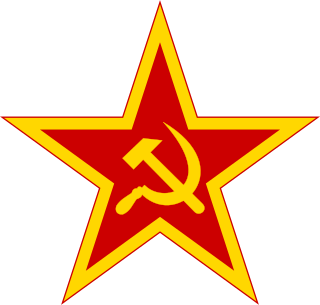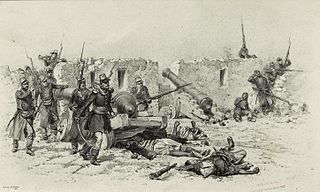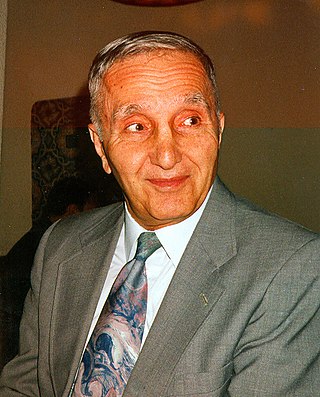Related Research Articles

A soldier is a person who is a member of an army. A soldier can be a conscripted or volunteer enlisted person, a non-commissioned officer, a warrant officer, or an officer.
Military science is the study of military processes, institutions, and behavior, along with the study of warfare, and the theory and application of organized coercive force. It is mainly focused on theory, method, and practice of producing military capability in a manner consistent with national defense policy. Military science serves to identify the strategic, political, economic, psychological, social, operational, technological, and tactical elements necessary to sustain relative advantage of military force; and to increase the likelihood and favorable outcomes of victory in peace or during a war. Military scientists include theorists, researchers, experimental scientists, applied scientists, designers, engineers, test technicians, and other military personnel.

A military, also known collectively as an armed forces, are a heavily armed, highly organized force primarily intended for warfare. Militaries are typically authorized and maintained by a sovereign state, with their members identifiable by a distinct military uniform. They may consist of one or more military branches such as an army, navy, air force, space force, marines, or coast guard. The main task of a military is usually defined as defence of their state and its interests against external armed threats.

A human wave attack, also known as a human sea attack, is an offensive infantry tactic in which an attacker conducts an unprotected frontal assault with densely concentrated infantry formations against the enemy line, intended to overrun and overwhelm the defenders by engaging in melee combat. The name refers to the concept of a coordinated mass of soldiers falling upon an enemy force and sweeping them away with sheer weight and momentum, like an ocean wave breaking on a beach.

A fireteam or fire team is a small modern military subordinated element of infantry designed to optimize "NCO initiative", "combined arms", "bounding overwatch" and "fire and movement" tactical doctrine in combat. Depending on mission requirements, a typical "standard" fireteam consists of four or fewer members: an automatic rifleman, a grenadier, a rifleman, and a designated fireteam leader. The role of each fireteam leader is to ensure that the fireteam operates as a cohesive unit. Two or three fireteams are organized into a section or squad in co-ordinated operations, which is led by a squad leader.
Morale is the capacity of a group's members to maintain belief in an institution or goal, particularly in the face of opposition or hardship. Morale is often referenced by authority figures as a generic value judgment of the willpower, obedience, and self-discipline of a group tasked with performing duties assigned by a superior. According to Alexander H. Leighton, "morale is the capacity of a group of people to pull together persistently and consistently in pursuit of a common purpose".. With good morale, a force will be less likely to give up or surrender. Morale is usually assessed at a collective, rather than an individual level. In wartime, civilian morale is also important.

The National People's Army were the armed forces of the German Democratic Republic (GDR) from 1956 to 1990.
Principles of war are rules and guidelines that represent truths in the practice of war and military operations.
Morris Janowitz was an American sociologist and professor who made major contributions to sociological theory, the study of prejudice, urban issues, and patriotism. He was one of the founders of military sociology and made major contributions, along with Samuel P. Huntington, to the establishment of contemporary civil-military relations. He was a professor of sociology at the University of Michigan and the University of Chicago and held a five-year chairmanship of the Sociology Department at University of Chicago. He was the Lawrence A. Kimpton Distinguished Service Professor at the University of Chicago. Janowitz was the vice-president of the American Sociological Association, receiving their Career of Distinguished Scholarship award, and a fellow of both the American Academy of Arts and Sciences and the American Philosophical Association. Janowitz also founded the Inter-University Seminar on Armed Forces and Society, as well as the journal Armed Forces & Society. He was an early founder of the field of military sociology. His students, such as David R. Segal, Mady Segal, and James Burk are prominent and influential military sociologists.

The Soviet Armed Forces, also known as the Armed Forces of the Soviet Union, the Red Army (1918–1946) and the Soviet Army (1946–1991), were the armed forces of the Russian SFSR (1917–1922) and the Soviet Union (1922–1991) from their beginnings in the Russian Civil War of 1917–1923 to the collapse of the USSR in 1991. In May 1992, Russian President Boris Yeltsin issued decrees forming the Russian Armed Forces, which subsumed much of the Soviet Armed Forces. Multiple sections of the former Soviet Armed Forces in the other, smaller Soviet republics gradually came under those republics' control.

Women in combat refers to female military personnel assigned to combat positions. The role of women in the military has varied across the world’s major countries throughout history with several views for and against women in combat. Over time countries have generally become more accepting of women fulfilling combat roles.

Guards units were elite units and formations in the Soviet Armed Forces that continue to exist in the Russian Armed Forces and other post-Soviet states. These units were awarded Guards status after distinguishing themselves in wartime service, and are considered to have elite status. The Guards designation originated during World War II, its name coming both from the Russian Imperial Guard, and the old Bolshevik Red Guards. Practical benefits of the status included double pay for ordinary soldiers and the designation often served as a morale-boosting source of unit pride.

Military sociology is a subfield within sociology. It corresponds closely to C. Wright Mills's summons to connect the individual world to broader social structures. Military sociology aims toward the systematic study of the military as a social group rather than as a military organization. This highly specialized sub-discipline examines issues related to service personnel as a distinct group with coerced collective action based on shared interests linked to survival in vocation and combat, with purposes and values that are more defined and narrow than within civil society. Military sociology also concerns civil-military relations and interactions between other groups or governmental agencies.

Combat is a purposeful violent conflict between multiple combatants with the intent to harm the opposition. Combat may be armed or unarmed. Combat is resorted to either as a method of self-defense or to impose one's will upon others. An instance of combat can be a standalone confrontation or part of a wider conflict, and its scale can range from a fight between individuals to a war between organized groups. Combat may also be benign and recreational, as in the cases of combat sports and mock combat.

Civil–military relations describes the relationship between military organizations and civil society, military organizations and other government bureaucracies, and leaders and the military. CMR incorporates a diverse, often normative field, which moves within and across management, social science and policy scales. More narrowly, it describes the relationship between the civil authority of a given society and its military authority. "The goal of any state is to harness military professional power to serve vital national security interests, while guarding against the misuse of power that can threaten the well-being of its people." Studies of civil-military relations often rest on a normative assumption that it is preferable to have the ultimate responsibility for a country's strategic decision-making to lie in the hands of the civilian political leadership rather than a military.

A penal military unit, also known as a penal formation, disciplinary unit, or just penal unit, is a military formation consisting of convicts mobilized for military service. Such formations may consist of military prisoners convicted under military law, civilian prisoners convicted in civilian courts, prisoners of war who have chosen to side with their captors, or a combination of these groups.

Sam Charles Sarkesian was a prominent scholar of civil-military relations and national security, who published numerous books and articles concerning various topics in these areas. He was also a member of the military, serving in Korea and Vietnam. He retired from the U.S. Army as a Lieutenant Colonel. He was also a professor emeritus of political science at Loyola University Chicago, where he was the chair of the political science department and influenced many new scholars in the field. He also served as the second president of the Inter-University Seminar on Armed Forces & Society (IUS). His memory is strong in the IUS, as many of its fellows were his students.
Unit cohesion in the United States military has been the subject of dispute and political debate since World War II as the United States military has expanded the categories of citizens it accepts as servicemembers. Unit cohesion is a military concept, defined by one former United States Chief of staff in the early 1980s as "the bonding together of soldiers in such a way as to sustain their will and commitment to each other, the unit, and mission accomplishment, despite combat or mission stress". The concept lacks a consensus definition among military analysts, sociologists, and psychologists.

James S. Burk is an American sociologist and professor at Texas A&M University. He is most notable as a scholar of military sociology, political sociology, and the history of sociology. He is a central figure in the study of civil-military relations in democratic societies.

Combat effectiveness is the capacity or performance of a military force to succeed in undertaking an operation, mission or objective. Determining optimal combat effectiveness is crucial in the armed forces, whether they are deployed on land, air or sea. Combat effectiveness is an aspect of military effectiveness and can be attributed to the strength of combat support including the quality and quantity of logistics, weapons and equipment as well as military tactics, the psychological states of soldiers, level of influence of leaders, skill and motivation that can arise from nationalism to survival are all capable of contributing to success on the battlefield.
References
- ↑ "Morale and Cohesion in Military Psychiatry, Fred Manning, p.4 in Military Psychiatry: Preparing in Peace for War, ISBN 0-16-059132-5; Manning cites Meyer, EC, "The unit", Defense, 1982;82(February):1-9
- 1 2 Brian Palmer (2010), "Pentagon Sees Little Risk in Allowing Gay Men and Women to Serve Openly" Slate, Dec. 1, 2010
- ↑ Cox, Alexander A. (1995). "Unit cohesion and morale in combat: survival in a culturally and racially heterogeneous environment" (PDF). For Leavenworth, KS: School of Advanced Military Studies. Archived (PDF) from the original on October 8, 2012. Retrieved 2011-04-25.
... Clausewitz makes the inference that the unit cohesion is more a factor of the morale of the unit as a whole rather than an equally decisive factor. He does not, however, underrate the value of cohesion. He wrote that the loss of order and cohesion in a unit often makes even the resistance of individual units fatal for them.
{{cite journal}}: Cite journal requires|journal=(help) - 1 2 van Epps (2008-12-31), "Relooking Unit Cohesion: A sensemaking approach", Military Review
- ↑ Czander, William (1993). The psychodynamics of work and organizations : theory and application. New York: Guilford Press. p. 21. ISBN 0-89862-284-0.
Freud maintains that cohesion is found in a group when all members introject the same subject into their ego ideal and then identify with each other. ... This phenomenon explains why soldiers willingly give up their thinking capacity and blindly follow orders from their leader. ... The soldiers as a group become a cohesive unit because they have all identified with each other.
- ↑ "Why soldiers fight. Part I. Leadership, cohesion and fighter spirit." Robert B. Smith, 1983, Quality & Quantity, Volume 18, Number 1, 1–32, doi : 10.1007/BF00221449
- ↑ Sigmund Freud (1922). Group Psychology and the Analysis of the Ego . Chapter V. Two Artificial Groups: The Church and the Army
- ↑ Giuseppe Caforio, Handbook of the Sociology of the Military, p.63, Springer, 2006. ISBN 0-387-32456-9. "The first attempt to establish a theory of cohesion and effectiveness within combat troops belongs to Edward Shils and Morris Janowitz (Shils and Janowitz, 1948). ..."
- ↑ Milam, John R. (2009). Not a gentleman's war: an inside view of junior officers in the Vietnam War, p. 142, UNC Press Books, ISBN 0-8078-3330-4
- ↑ George, Alexander (1967). The Chinese Communist Army in Action: The Korean War and its Aftermath . New York, NY: Columbia University Press.
- ↑ George 1967, p. vii.
- ↑ George 1967, p. 27.
- ↑ George 1967, p. 29.
- ↑ George 1967, pp. 31–35.
- ↑ George 1967, pp. 36-38.
- ↑ George 1967, p. 5.
- ↑ George 1967, p. 164.
- ↑ George 1967, p. 195–196.
- ↑ Roger Kaplan (1987). "Army Unit Cohesion in Vietnam: A Bum Rap" , U.S. Army War College.
- ↑ Anthony King, "The Word of Command: Communication and Cohesion in the Military," Armed Forces and Society 32, 4 (2006): 493–512; Guy L. Siebold, "The Essence of Military Group Cohesion," Armed Forces and Society 33, 2 (2007), 286–295; Anthony King, "The Existence of Group Cohesion in the Armed Forces: A Response to Guy Siebold," Armed Forces and Society 33, 4 (2007): 638–645.
- ↑ Guy L. Siebold, "The Evolution of the Measurement of Cohesion," Military Psychology 11, 1 (1999). For an interesting example see Osiel, Obeying Orders: Atrocity, Military Discipline, and the Law of War.
- ↑ Paul Bartone and Amy Adler, "Cohesion over Time in a Peacekeeping Medical Task Force," Military Psychology 11, 1 (1999); Uzi Ben-Shalom, Zeev Lehrer, and Eyal Ben-Ari, "Cohesion During Military Operations: A Field Study on Combat Units in the Al-Aqsa Intifada," Armed Forces and Society 32, 1 (2005).
- ↑ Terence Lee, "Military Cohesion and Regime Maintenance: Explaining the Role of the Military in 1989 China and 1998 Indonesia," Armed Forces and Society 32, 1 (2005): 80–104; Terence Lee, "The Armed Forces and Transitions from Authoritarian Rule: Explaining the Role of the Military in 1986 Philippines and 1998 Indonesia," Comparative Political Studies 42, 5 (2009): 640–69.
- ↑ Lucan A.Way and Steven Levitsky, "The Dynamics of Autocratic Coercion after the Cold War," Communist and Post-Communist Studies 39 (2006): 387–410.
- ↑ Jesse Lehrke, "A Cohesion Model for Assessing Military Arbitration of Revolutions." Armed Forces & Society 0095327X12459851, first published on 22 January 2013 as doi: 10.1177/0095327 X12459851 (Print edition forthcoming 2013, OnlineFirst at: http://afs.sagepub.com/content/early/2013/01/18/0095327X12459851).
- ↑ Dale R. Herspring, "Undermining Combat Readiness in the Russian Military, 1992–2005" Armed Forces & Society 32, 4 (2006): 513–531; Jesse Paul Lehrke, The Transition to National Armies in the Former Soviet Republics, 1988–2005 (Oxfordshire, UK: Routledge, 2013).